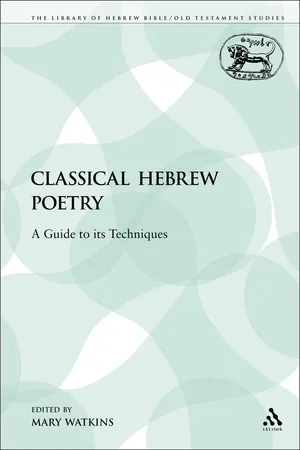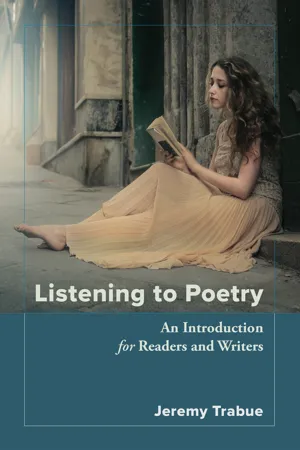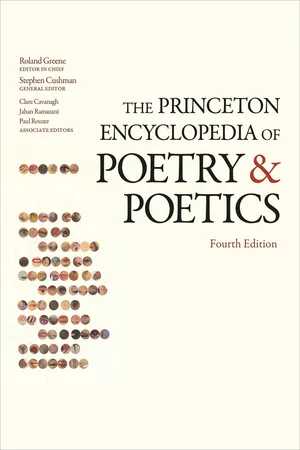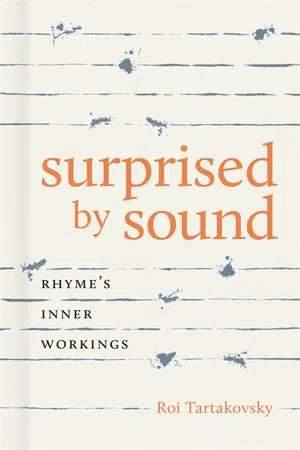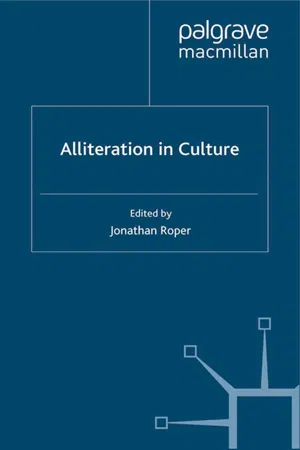Literature
Assonance
Assonance is a literary device that involves the repetition of vowel sounds within words in close proximity. It is used to create a musical or rhythmic effect in poetry and prose. By repeating similar vowel sounds, assonance can enhance the mood, tone, and overall musicality of a literary work.
Written by Perlego with AI-assistance
Related key terms
1 of 5
6 Key excerpts on "Assonance"
- eBook - PDF
Classical Hebrew Poetry
A Guide to its Techniques
- Wilfred G. E. Watson(Author)
- 1984(Publication Date)
- Sheffield Academic Press(Publisher)
Useful is A.A. Hill, 'A Phonological Description of Poetic Ornaments', LS 2 (1969) 99-123. Sound in Hebrew Poetry 223 Assonance is a form of vowel repetition. It occurs when there is a series of words containing a distinctive vowel-sound 3 or certain vowel-sounds in a specific sequence. However, since the borderline between vowels and consonants is not irrevocably defined, there is some overlap between alliteration (of consonants) and Assonance (of vowels). This is inevitable since poets are not phoneticians and deal with words, not abstract entities. For convenience, though, alliteration has been dealt with separately. Yet another section will deal with com-binations of alliteration and Assonance. Here, the topic is Assonance. Typology of Assonance The simplest form of Assonance is based on the repetition or dominance of a single vowel sound. In Jer 49,1 the distinctive 'A'-sound is evidently to be heard throughout the couplet: 4 madua'ydras malkdm 'et-gdd Why has their king5 inherited Gad vf'ammd be'drdyw ydsdb and his people settled in his cities? Also in Ps 48,7a. In Jer 49,8 it is 'E', in Ps 113,8 T, in Isa 58,12d and Job 5,21 'O' and in Lam 4,15 'U'. Assonance becomes more complex when based on certain vowel sequences; for example, in Job 9,16b: lo' 'a^min ki ya^zin qoli I do not believe he would listen to my voice. 3. Here, cases have not been limited to either final-vowel Assonance (called Vocalic rhyme') or stressed-vowel Assonance. 'Assonance occurs when two words have the same vowels but different consonants' (Elkhadem, Dictionary, 14). According to Adams: 1973, 8, Assonance is 'the repetition of a stressed vowel, but not of a following consonant or consonant cluster, in syllables near enough to each other for the echo to be discernible to the ear'; and it is 'a conscious musical device in poetry of all countries' (ibid. 9). 4. In this section the Hebrew is given in transliteration so that the sound is immediately evident. - Available until 18 Jan |Learn more
Listening to Poetry
An Introduction for Readers and Writers
- Jeremy Trabue(Author)
- 2019(Publication Date)
- Chemeketa Press(Publisher)
Rhyme is only the first of many kinds of patterns that poets make by repeating sounds within and between lines. Alliteration is a pattern of repeated initial word sounds. Repetition of consonant and vowel sounds within words—as opposed to at the beginning or end of words—are known as consonance and Assonance. Onomatopoeia is the use of words that sound like what they describe. Being aware of, and developing the habit of looking systematically for, other patterns of repetition is a vital tool in understanding and appreciating the music of poetry.To finish off the chapter, here’s a list of reminders, tips, and tricks to help you as you work with the musical language of poems:• Read out loud, listen to others read, and annotate the poem as you listen. Be sure to take notes as you go, as the pattern may not emerge at first. Finding alliteration is not a lot different than finding rhyme.• Be more attentive to syllables than to words. Alliteration is strongly linked to the pattern of stressed syllables. • Remember to listen to sounds instead of looking for spelling. Look up words if you’re not sure how to pronounce them. You don’t have to and shouldn’t guess.• It can be tough to isolate vowel and consonant sounds from each other and thus to hear Assonance or consonance. In addition to patience, your best friend is the dictionary, which includes a pronunciation guide for every word.• Notice how much of the consonance and Assonance in “Counting-Out Rhyme” is tied into the rhymes. Assonance and consonance tend to get drowned out in isolation, but they are accented and highlighted when used in conjunction with other musical effects.• Onomatopoeia is more than “words that don’t mean anything but the sound they seem to make.” Whenever a poet uses letters and words to create sounds that mimic or evoke natural sounds, we’re in the world of onomatopoeia.• Be attentive to the overall pattern of sounds in the poem and the effects they create. There’s no secret Poets-Only Onomatopoeia Decoder Ring that indicates “word sound X = sound from life Y - eBook - ePub
The Princeton Encyclopedia of Poetry and Poetics
Fourth Edition
- Stephen Cushman, Clare Cavanagh, Jahan Ramazani, Paul Rouzer, Stephen Cushman, Clare Cavanagh, Jahan Ramazani, Paul Rouzer(Authors)
- 2012(Publication Date)
- Princeton University Press(Publisher)
The Poetry Review 97 (2007).T. FURNISSCONSONANCE. In *prosody, consonance refers most strictly to the repetition of the sound of a final consonant or consonant cluster in stressed, unrhymed syllables near enough to be heard together, as in Robert Lowell’s “iron ic rain bow” and “Gobb ets of blubb er” or Robert Browning’s “Rebuck led the cheek -strap, chained slack er the bit,” where three final k sounds emphasize the stressed syllables buck -cheek -slack . Consonance parallels the repetitions in *alliteration (initial consonant) and *Assonance (vowel) and can be combined either within a syllable to produce other effects, such as *rhyme (Assonance + consonance) or pararhyme (alliteration + consonance). Critics have sometimes used the terms consonance, Assonance , and alliteration interchangeably with some loss of precision. Consonance also sometimes specifically denotes cases of pararhyme, an effect commonly found in early Celtic, Germanic, and Icelandic poetry, and in W. H. Auden’s “r ead er to r id er” or in early Ren. verse such as Luigi Pulci’s “Stille le stelle ch’a tetto era tutta.” This effect has been referred to alternately as bracket rhyme , bracket alliteration , bracket consonance , or rich consonance , though it may be useful to distinguish this double echo from the single echo of final consonant repetition. This would allow one to say that “rider” both alliterates and consonates with “reader,” while in f ur -f air , f alliterates and r consonates. Consonance has often fallen loosely under the terms half rhyme , near rhyme , or slant rhyme , which may blur the distinction between differing vowel and consonant echoes. Combinations that appear to rhyme to the eye, such as lov e-mov e, may only consonate, though some such pairs are accepted by convention as rhyme. Several critics have identified other instances of “partial” or “semi” consonance when, e.g., one or more echoes involve slightly differing clusters, as in Dylan Thomas’s pairing plat es -hearts , which differs by the r in hearts but retains the t-s echo in both. Likewise, one may find “close” consonance between voiced and unvoiced final consonant echoes, as in the f and v of wife -lov e or s and z of hears e-war es . Consonance becomes more subtle, and harder to hear, between complex vowel or glide endings, as in the y of day -li e, also sometimes called semiconsonance - eBook - ePub
Surprised by Sound
Rhyme's Inner Workings
- Roi Tartakovsky(Author)
- 2021(Publication Date)
- LSU Press(Publisher)
1 Hearing and Listening to Rhyme If negotiating with linguistic constraints and literary conventions comes with the territory of writing poetry, rhyme occupies a great part of that territory. Certainly, in the case of English, it is difficult to overstate the association between rhyme and poetry, or the significance of rhyme to poetry. This association is attested to in rhetoric by rhyme’s synecdochic or metonymic substitution for poetry itself. Rhyme-as-poem is a prevalent trope throughout much English-language poetry and is nowhere more evident than in William Shakespeare’s ending of Sonnet 17: “You should live twice, in it and in my rhyme.” In practice, rhyme’s prevalence is attested to by the overwhelming number of rhymed poems written by generations of poets. Of course, rhyme is not the only sound device, nor the earliest in the history of English poetry. A perfect or full rhyme is, in fact, one of numerous poetic sound devices, including Assonance, alliteration, consonance, and many forms of partial rhymes. But it is the more encompassing member among most of these weaker or partial sound relations because full rhyme typically requires a correspondence of both the vowel and the following consonant sounds of the last stressed syllable of each word. 1 Assonance was never used systematically in English verse, partial rhyme is best appreciated as a subset of full rhyme, and alliteration, while carrying its own historical connotations of Anglo-Saxon prosody, seems, at least in poetic consciousness, more distant and dimmed today than rhyme. 2 Rhyme, both historically and phonetically, is set up to stand out in the soundscape of the poem or of poetry. As prevalent as rhyme is (or was —a question I will get to momentarily), it is easy to forget that rhyme’s entry into English poetry was a gradual process and one that—in spite of scholarly interest—remains somewhat murky. Murkier yet is the larger question of the historical origin of rhyme itself - Mick Short(Author)
- 2018(Publication Date)
- Routledge(Publisher)
I M and 191, on the other hand, are both dental fricatives, produced by pushing the tongue tip against the back of the teeth. This description is not enough to enable you to relate all similar consonants together, but it should help you to check that the similarities and differences between sounds can be explained by examining the phonetic facts. If you want to take this kind of examination a step further, see Knowles (1987: Chs 2-3). 4.2.2 Assonance Assonance is the term traditionally reserved for patterns of repetition between vowel sounds. In example 5 the words withered, nipped and shivering are connected by Assonance: Example 5 I, like yon wither'd leaf, remain behind, Nipped by the frost, and shivering in the wind; (George Crabbe, 'The Village', I, 210-11) Both the speaker and the withered leaf have been affected by the frost (withered, nipped) and as a result both appear to be shivering. Assonance, like alliteration, connects important words together and helps the reader notice meaning- connections between them. Although there are only five vowel letters in the English spelling system, there are twelve pure vowel sounds in 'BBC' English, and even more vowel sounds if we include the diphthongs (e.g. the vowel sounds in 'play' and 'boy'), sounds which consist of a glide from one pure vowel sound to another. Vowels are distinguished from one another according to whether they are long or short and where the highest point of the tongue in the mouth is along the co- ordinates low-mid-high and front-mid-back. Thus the Iii of 'bit' and the /i:l of 'beet' will be felt to be similar because they are both high front vowels, differing from one another mainly through the feature of length (the symbol ':' after a vowel indicates that it is long). 112 Exploring the language of poems, plays and prose Vowel length is something which is not difficult to perceive.- eBook - PDF
- Jonathan Roper(Author)
- 2011(Publication Date)
- Palgrave Macmillan(Publisher)
234 Alliteration in Culture and claims that they are fundamentally very similar phenomena (both involve repetition of syllables, copying prosodically prominent syl- lables) but with one important difference: alliteration requires greater proximity than rhyme. Whereas rhyme occurs at the end of each line, alliteration can take place between consecutive words within the same line. The repeated sounds’ closeness to one another creates a unifying aural effect throughout the passage. Alliteration in this sense is linked with the concepts of ‘structural echoes’ or ‘chiming effect’. Tamplin (1993) values highly the function of what he calls ‘structural echoes’, the same quality of sounds spreading over a poem, in unifying various aspects of the poem, especially in creating a metaphorical relationship between sound and form. A chiming effect is defined as ‘a phonetic bond between words’ (Leech 1969), and, like the notion of structural ech- oes, it is often metaphorically associated with the theme of the poem. Alliteration can be understood as a special case of chiming effect, where the echoing sounds are restricted to the initial consonants of words or syllables. This metaphorical function of alliteration is especially indispensable for poetic language, and it can be found in sign language poetry as well. I will discuss the symbolic nature of alliteration in a later section of this chapter. Sign language poetry Sign language poetry can be defined as a piece of poetic signing origi- nally composed and performed in a sign language by a Deaf person. It is different from ‘Deaf poetry’ which refers to any poetic activity that involves Deaf people, including poems composed by Deaf people in written language. It is also distinguished from the translation from spoken/written poetry. In short, sign language poetry is original work of Deaf people in their own language. Poetry is the height of linguistic activities in any language.
Index pages curate the most relevant extracts from our library of academic textbooks. They’ve been created using an in-house natural language model (NLM), each adding context and meaning to key research topics.
